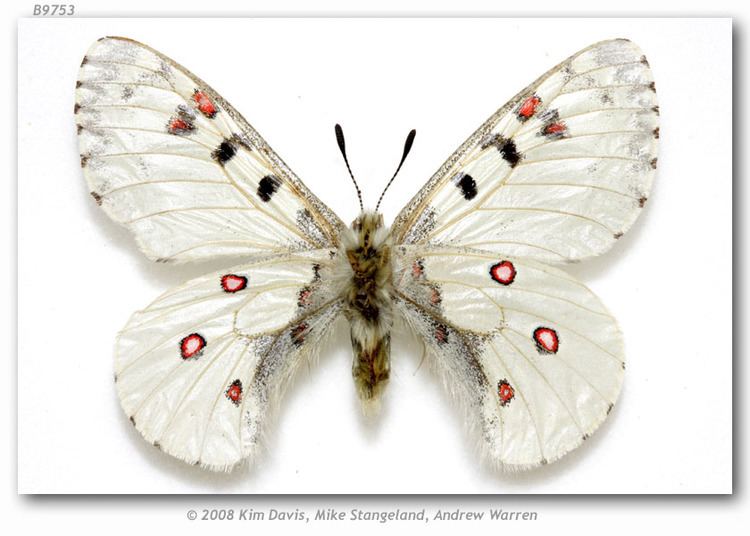Kingdom Animalia Class Insecta Family Papilionidae Scientific name Parnassius smintheus | Phylum Arthropoda Order Lepidoptera Genus Parnassius Rank Species | |
 | ||
Similar Parnassius clodius, Parnassius, Speyeria hesperis, Papilio indra, Speyeria mormonia | ||
Parnassius smintheus female lays an egg on a rock
Parnassius smintheus, the Rocky Mountain parnassian or mountain parnassian, is a high-altitude butterfly which is found in the United States and Canada. It is a member of the snow Apollo genus (Parnassius) of the swallowtail family (Papilionidae).
Contents
- Parnassius smintheus female lays an egg on a rock
- Description
- Imago
- Early stages
- Biology
- Subspecies
- Distribution
- Similar species
- References
Description
This mostly white butterfly has red spots in the centres of the hindwing that distinguish it from other Parnassians. They also have dark spots on the forewing and dark wing margins and submargins. Although this butterfly is in the swallowtail family it has no tail.
Imago
Ground-colour chalk white, forewing with the peculiar black spots of the apollo-group in the typical form an incomplete submarginal band on the forewing, the costal spot faintly centred with red, the transparent border narrow at the outer margin, commonly only extending to the middle of the wing, interrupted by white marginal spots, the white fringes spotted with black at the extremities of the veins; hindwing with two small ocelli, filled in with red, hindmarginal spot as a rule weakly indicated. Female as a rule somewhat larger, forewing with larger costal spots, filled in with red, strong hindmarginal spot and broader margin, hindwing with larger ocelli, one or two anal spots filled in with red and a row of submarginal crescent spots. Extraordinarily variable in size and markings, in the male the submarginal band of the forewing sometimes more strongly developed, the glassy border very variously developed, the white patches of the same sometimes more weakly, sometimes more strongly expressed, occasionally a stronger black spot in the hindmarginal area, the costal spots also quite black, more copiously dotted with red or white; on the hindwing the anal spot in individual instances more distinct and near the margin sometimes some blackish spots. In the females, particularly those from high flying localities, more copious black marking and partial darkening of the white ground-colour are of no uncommon occurrence, also in both sexes individuals often occur with yellowish instead of red ocelli, which are usually referred to behrii. But this name must be reserved for the Western race of the species. Specimens without red on the upper surface, in which even the ocelli of the hindwing are reduced to black spots, are usually called ab. sedakovii Men. This is, however, an Asiatic form of P. phoebus F. and the name has been replaced by ab. mendica Sitchel.
Early stages

The egg is semispherical, somewhat depressed at the top, the upper surface thickly granulated, the colour ivory white with a faint greenish tint. The young larva is nearly cylindrical, of black colour, the body covered with small hairy tubercles. When full grown it attains a length of 23–25 mm (0.91–0.98 in), the groundcolour is then black-brown, brown on the underside and the legs, the body covered with short stiff hairs and marked with four rows of yellow, sometimes white spots; it has a fork-shaped, eversible yellowish gland in the neck; the head is broad, with impressed suture, of black colour. Pupa cylindrical, stout, about 15 mm (0.59 in) long, the upper surface finely granulated, of yellow-brown colour with greenish reflection.
Biology
They have one flight, from June to mid-August. Development variable, some eggs yield the larvae in the same year, others hibernate. Larvae feed on Sedum lanceolatum, Sedum roseum, Sedum divergens, Sedum stenopetalum, and Sedum oreganum.
When the larva is about to pupate it draws a leaf or several leaves together into a sort of cocoon by some silken threads, but pupae have also been found on the ground under pieces of wood without a trace of a cocoon.
Subspecies
Listed alphabetically.
Distribution
From mountainous areas of Yukon, Alaska, and British Columbia and south as far as New Mexico.
The Rocky Mountain parnassian lives throughout the western United States year-round. It is found in all of the life zones of the Rocky Mountains, including the montane, subalpine and alpine zones.
